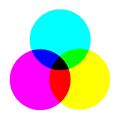Color: Difference between revisions
imported>Robert W King |
imported>Robert W King |
||
| Line 15: | Line 15: | ||
The second model is ''subtractive'' color(image left), which defines how we see color when it is physically applied to a media. The color that we might see when we use crayons on paper comes from the light which is ''not'' reflected back to us. When we mix different colors of paint, we are increasing the amount of wavelength frequencies absorbed, ''reducing'' the amount that is reflected back to us. | The second model is ''subtractive'' color(image left), which defines how we see color when it is physically applied to a media. The color that we might see when we use crayons on paper comes from the light which is ''not'' reflected back to us. When we mix different colors of paint, we are increasing the amount of wavelength frequencies absorbed, ''reducing'' the amount that is reflected back to us. | ||
Despite these being two seperate systems, there is a common pool of terms that can be used to describe color. | Despite these being two seperate systems, there is a common pool of terms that can be used to describe color, in the context of the physical properties of [[light]]. | ||
''Hue'': Hue is what we used to describe the color that we see, either a red, or an orange, or purple. | ''Hue'': Hue is what we used to describe the color that we see, either a red, or an orange, or purple. | ||
Revision as of 11:47, 13 July 2007
Color is the observation of light as it is reflected or absorbed by the human eye and processed by the brain. The actual distinction of colors occurs within the inner layer of the eye, the retina.
Inside the retina, four different kinds of light-sensitive receptors exist. The first are rods, which are responsible for general light absorption. The next three types are cones that absorb varied wavelengths. The length of the waves determines what kind of color is absorbed. Long wavelength absorbtion produces red colors; middle wavelengths produce greens; short wavelengths produce blues.
The capability for these cone receptors to absorb different wavelengths exists because of the pigments within them: a transmembrane protein called opsin which binds to the prosthetic group retinal, a type of Vitamin A. Rods employ a different kind of pigment called Rhodopsin, which is in the membrane of the outer section.
Rods are extremely sensitive to light. A single photon is enough to send signals to the brain.
The Spectrum
There are primarly seven groups of wavelengths that when interpreted in different ways are capable of producing the billions of observable colors that we see. Those groups are represented by a familiar mnemonic device: Roy G Biv, which stands for Red, Orange, Yellow, Green, Blue, Indigo, Violet.
Even though all color is defined by the absorption of light in the eye, two different models exist for defining the application of color. The first is additive color(image right), whereby red, blue, and green light can be overlapped to produce the spectrum; white light exists where they all intersect at the midpoint. This model is representative of the way color is produced by monitors, televisions, projectors, lamps, etc. The more colors that are produced using this method, the more wavelength frequencies that are present. In essence, we are seeing more light being reflected back to our eyes.
The second model is subtractive color(image left), which defines how we see color when it is physically applied to a media. The color that we might see when we use crayons on paper comes from the light which is not reflected back to us. When we mix different colors of paint, we are increasing the amount of wavelength frequencies absorbed, reducing the amount that is reflected back to us.
Despite these being two seperate systems, there is a common pool of terms that can be used to describe color, in the context of the physical properties of light.
Hue: Hue is what we used to describe the color that we see, either a red, or an orange, or purple.
Saturation: Saturation describes how much grey is in a color--its "purity".
Value (also Brightness): We use value to describe how bright or dark a color is; specifically, how much light or white is in a color.
Opacity: Opacity is the capacity to obstruct visible light. Glass has a relatively low opacity compared to concrete.
Transparency: Something is described as transparent when it has the property of being able to transmit light without scattering it. Although most glass can be described as transparent, there are ways to affect this property either by "frosting" or damaging it's surface in such a way that it can retain the same opacity, but the ability to see through it is diminished.
Production of Color
Today, most physical implementations of color are the result of different pigments or dyes, the primary difference being that pigments are typically organic or inorganic materials that are insoluble--the particles in the medium do not break down and are distinct, whereas dyes do not retain this particle property and dissolve. Pigments usually retain the colourization longer than dye, and allow for greater variance in color depth (the combination of hue, saturation, and value).
Dyes usually do not change the transparency or opacity of the medium, where as pigments can do both. Food coloring, for example, changes the colour of water; paint is diluted by it but affects the visibility through it.

